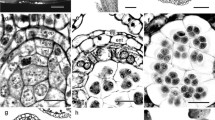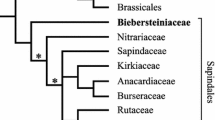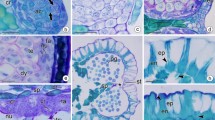Abstract
In this paper we present the first results concerning the embryology of Chrysobalanaceae. In it, we document developmental features of anthers, ovules, seeds and gametophytes ofChrysobalanus andLicania (tribe Chrysobalaneae). Based on our results with these two genera, Chrysobalanaceae have a distinctive combination of embryological features. They differ from Rosaceae (in which Chrysobalanaceae were once placed as a tribe or subfamily) in having a tenuinucellate ovule, a small nucellus with the tissue soon disintegrating, and an endothelium. None of our embryological of Rosales, or with other groups such as Fabaceae or Myrtales, which have also been suggested as relatives. We propose, based upon the evidence from embryology, vegetative features, and reproductive morphology, that Chrysobalanaceae might best be placed in the order Theales, probably near the family Theaceae.
Similar content being viewed by others
References
Bala-Bawa, S. 1970. Theaceae.In: B.R. Seshachar, ed., Proceedings of the Symposium on Comparative Embryology of Angiosperms, held in 1967 in Dehli. Bull. Indian Nat. Sci. Acad.41: 75–77.
Corner, E.J.H. 1976. The Seeds of Dicotyledons. 2 vols. Cambridge University Press, Cambridge.
Cronquist, A. 1981. An Integrated System of Classification of Flowering Plants. Columbia Univ. Press, New York.
Dahlgren, R. 1983. General aspects of angiosperm evolution and macrosystematics. Nord. J. Bot.3: 119–149.
Dahlgren, R. and R.F. Thorne. 1984. The order Myrtales: circumscription, variation, and relationships. Ann. Missouri Bot. Gard.71: (in press).
Davis, G.L. 1966. Systematic Embryology of the Angiosperms. John Wiley & Sons, New York.
Dickison, W.C. 1981. The evolutionary relationships of the Leguminosae.In: R.M. Polhill and P.H. Raven, ed., Advances in Legume Systematics, Part 1, p. 35–54. Royal Botanic Gardens, Kew.
Dnyansagar, V.R. 1970. Leguminosae.In: B.R. Seshachar, ed., Proceedings of the Symposium on Comparative Embryology of angiosperms, held in 1967 in Dehli. Bull. Indian Nat. Sci. Acad.41: 93–103.
Erdtman, G. 1952. Pollen Morphology and Plant Taxonomy. Angiosperms. Chronica Botanica, Waltham, Massachusetts.
Fritsch, C. 1888. Über die Gattung der Chrysobalanaceen. Verh. Zool-Bot. Ges. Wien38: 93–95.
Gutzwiller, M.A. 1961. Die Phylogenetische Stellung vonSuriana maritima L. Bot. Jahrb. Syst.81: 1–49.
Hallier, H. 1923. Beiträge zur Kenntnis der Linaceae (DC. 1819). Dumort. Beih. Bot. Centralbl.39: 1–178.
Hauman, L. 1951. Contribution a l'etude des Chrysobalanoides africaines Bull. Jard. Bot. Etat21: 167–198.
Hegnauer, R. 1973. Chemotaxonomie der Pflanzen. Vol. 6. Birkhäser Verlag, Basel.
Juel, H.O. 1915. Über den Bau des Gynöceums beiParinarium. Ark. Bot.14: 1–12.
Metcalee, C.R. andL. Chalk. 1950. Anatomy of Dicotyledons. 2 vols. Oxford Univ. Press, Oxford.
Narayana, L.L. 1975. A contribution to the floral anatomy and embryology of Ochnaceae. J. Jap. Bot.50: 329–336.
Netolitzky, F. 1926. Anatomie der Angiospermen Samen. Linsbauer Handb. Pfl. Anat. vol. 10. Gebrüder Borntraeger, Berlin.
Prance, G.T. 1972. Chrysobalanaceae. Flora Neotropica Monogr. No. 9. Hafner Publs. New York.
—,D.J. Rogers andF. White. 1969. A taximetric study of an angiosperm family: generic delimitation in the Chrysobalanaceae. New Phytol.68: 1203–1234.
Ram, M. 1956. Floral morphology and embryology ofTrapa bispinosa, with a discussion on the systematic position of the genus. Phytomorphology6: 312–323.
Schmid, R. 1982. Descriptors used to indicate abundance and frequency in ecology and systematics. Taxon31: 89–94.
— andM.D. Turner. 1977. Contrad 70, an effective softener of herbarium material for anatomical study. Taxon26: 551–552.
Takhtajan, A.L. 1980. Outline of the classification of flowering plants (Magnoliophyta). Bot. Rev.46: 225–359.
Thorne, R.F. 1983. Proposed new realignments in angiosperms. Nord. J. Bot.3: 85–117.
Tobe, H. andP.H. Raven. 1983a. An embryological analysis of the Myrtales: its definition and characteristics. Ann. Missouri Bot. Gard.70: 71–94.
. 1983b. The embryology ofAxinandra zeylanica (Crypteroniaceae) and the relationships of the genus. Bot. Gaz.144: 426–432.
Vaughan, J.G. 1970. The Structure and Utilization of Oil Seeds. Chapman & Hall Ltd., London.
Webb, J.E. 1902. A morphological study of flower and embryo ofSpiraea. Bot. Gaz.33: 451–460.
Wettstein, R. 1933. Handbuch der Systematischen Botanik, 4 ed. Franz Deuticke, Leipzig.
Author information
Authors and Affiliations
Rights and permissions
About this article
Cite this article
Tobe, H., Raven, P.H. An embryological contribution to systematics of the Chrysobalanaceae I. Tribe Chrysobalaneae. Bot Mag Tokyo 97, 397–411 (1984). https://doi.org/10.1007/BF02488671
Received:
Issue Date:
DOI: https://doi.org/10.1007/BF02488671




